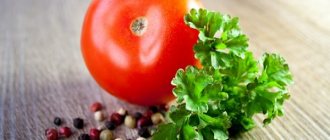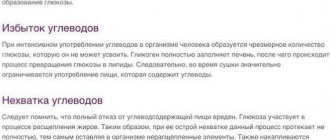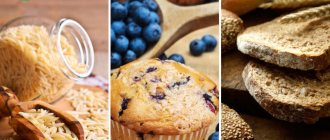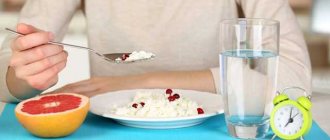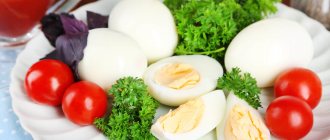Diet for drying the body highlights
Before moving on to the menu, let's discuss the main points of the diet for drying the body that people encounter. Where to start and how to dry properly. The first thing to realize is that if you have a sufficient amount of belly, sides, and fat, you won’t get to your abs with just one cut or one diet.
So that it would be so beautiful and embossed. What will start to happen? You will start cutting out carbohydrates, gradually go on a diet, if you do everything correctly, you will lose weight. The waist will become narrower, the muscles will become more defined. But most likely you won’t achieve this in one drying session. That is, at some stage the body will turn on protective reactions and you most likely will not be able to remove your subcutaneous fat, for example from 30% to 8%. The result we are talking about, so that you really have abs, is achieved in stages, not from the first drying. If we talk about my experiments, I achieved not bad results in two drying sessions.
It very often happens that a person comes to the gym with a belly fat, a trainer gives him exercises and diets, the person begins to work and reaches a certain stage when his body is already in a stupor, the weight does not go away, the person is already exhausted.
And he tries to dry further, to remove the last layer of fat, but he doesn’t succeed. Because the metabolism is already as slow as possible, the body has given up a lot of fat. All this leads to the fact that a person gets exhausted, stops exercising and starts again. If not all the weight he had, then at least part of it. Hence the second rule of the diet for drying the body: Do not push your body into too strict limits.
Very often beginners, people who are enthusiastic and have good willpower. They work and exhaust themselves as if they are preparing for the Olympia. Give your body a break. If you see that you have already reached the stage when you are on a strict diet, you only have carbohydrates for breakfast, or you remove them altogether. And the weight does not fall, the fat layer does not burn or burns, but only a teaspoon at a time. In this situation, I recommend that you stop and add not a lot of carbohydrates. To speed up the metabolism, give the body a rest. And only later, when you have rested and recovered psychologically. Your body has returned to more or less normal mode, but with less fat. Then you can remove carbohydrates again. And already the fat layer that you have left to dry.
As this usually happens during muscle gain and cutting, when you start either adding or removing carbohydrates. From the very beginning the body reacts very well. In the first week you lose weight very quickly, your fat burns, there is a result, you are satisfied. Then the further you continue, the more your process slows down. In these situations, it becomes futile to try to burn several hundred grams of fat while on such strict diets. It's much easier to start adding carbohydrates without loading up too much. He may not even gain much in kilograms. But again invigorate the body, bring it back to normal. And then remove the carbohydrates again. When you remove them, your body will begin to quickly burn your fat again. This fat layer dries very well.
Diet for drying the body The third point is to include a cheat meal in our menu.
That is, this is the day when we allow ourselves to eat whatever we want. No matter what kind of willpower a person has, no matter what kind of mentality he has, he still wants sweets on a diet, he wants everything that he can’t eat. Very often what begins is that people slowly break down. It is better to give up all these products for a week. But set aside one day a week to eat these foods. That is, you are on a diet for 9 days, and on the 10th day you load up. Psychologically this is a very important thing. When you know that you are limiting yourself, but that you can eat whatever you want on the weekend, this is very motivating. In addition to psychological relief, this is a good stimulus for the body. Metabolism accelerates very quickly because you give the body a lot of energy from simple carbohydrates. And he needs to process and synthesize all this energy. All metabolic processes are accelerated, metabolism increases. You go on a diet, and against the backdrop of an accelerated metabolism, your body easily burns through what you loaded into it.
Another point of the diet for drying the body is to control what you dry.
Watch your weight. If you see your weight plummeting, it may be better to slow down a little. It’s one thing if you weighed 150 kilograms and losing a few kilograms a week is normal. But if you weigh 90 kilograms and start losing weight by two kilograms a week. Maybe we should slow down a little. Why?
Because beginners are often very enthusiastic and remove large amounts of carbohydrates. And they immediately begin to lose weight. The muscles begin to crumble. A person decreases in volume very quickly and this is very stressful for the body. I recommend cutting out carbohydrates gradually. Firstly, this way you will save more muscle. Secondly, it will not be such a big stress for your body when you do all this gradually.
General nutrition rules
Initially, the term “cutting” was used by athletes who sought to achieve body definition and minimize the percentage of subcutaneous fat deposits. Nowadays, this nutrition system is chosen by many girls who want to achieve beautiful shapes and a slim body at home. After all, drying allows you to lose extra pounds in a short time.
Protein foods become the basis of the diet, the amount of carbohydrates is reduced to a minimum. Due to this, the body begins to draw energy from fat deposits. The correct ratio of macronutrients during cutting looks like this:
- 60% protein – lean meat, offal, fish, any seafood, cottage cheese, hard cheese, eggs;
- 30% carbohydrates – protein cereals (buckwheat, oatmeal, quinoa, amaranth, brown rice), greens, vegetables, green fruits (in small quantities);
- 10% saturated fat – nuts, vegetable oils, seaweed, avocado.
For 1 kilogram of your weight there should be 2 grams of protein, 1 gram of carbohydrates, 0.5 grams of fat. To maintain a good metabolism, you need to consume at least 1200 calories in just a day. Therefore, while you are cutting, it is best to keep a food diary.
Incredible result
Thanks to the large amount of protein, the body retains muscles and remains toned. In addition to this, at least minimal physical activity is recommended during drying.
All harmful foods are strictly prohibited - sweets, fast food, processed foods, mayonnaise and sauces. Bread, pasta, most cereals (except protein and in small quantities) and alcohol are also excluded from the menu.
How long can you maintain this diet ? Up to 6 weeks, gradually reducing the amount of carbohydrates. Longer is undesirable, since a large amount of protein can begin to negatively affect kidney function. And a long-term absence of carbohydrates can significantly worsen your well-being - lead to lethargy, apathy and dizziness. Approximately up to 2-2.5 kilograms of excess weight are lost per week.
The key to success is properly prescribed daily nutrition. The menu presented below for 2 weeks is not the strictest option for drying the body for girls. It also contains healthy fats (which nourish our hair, skin, nails), as well as the amount of carbohydrates that will not deprive you of energy and will ensure good health. The main principle of such nutrition is weight loss, which does not harm the body.
What products are allowed to dry in 2 weeks?
We will not list the list of foods that need to be excluded from the diet when drying the body - it will take a lot of time, so we will analyze the food that will allow you to achieve positive results. The following proteins are considered optimal:
- lean fish with seafood;
- poultry meat (chicken breast, turkey);
- veal and rabbit;
- legumes;
- eggs (mostly whites);
- dairy products, but low-fat.
As was said, the amount of carbohydrates during drying decreases over 2 weeks, but they cannot be completely eliminated - this is dangerous to health. Sources of healthy carbohydrates for girls and men on a dry diet include durum pasta, cereals, oatmeal, and vegetables. You should also include some fat in the form of olive oil in the 2-week drying menu, and it is also present in meat and fish in small quantities.
Example of a drying menu for girls
There should be 12 hours between your last meal and breakfast. This will speed up the body's metabolic processes. The best option is a light dinner 3 hours before bedtime, and a hearty breakfast 30-60 minutes after waking up. You need to start your morning with a certain ritual - drink 2 glasses of water at room temperature on an empty stomach. Thanks to this ritual, the functioning of the gastrointestinal tract is normalized, and metabolic reactions proceed faster. Active fat burning is promoted by eating small portions, 3-5 times a day.
Please note: that for some drying girls it is better to eat only 3 times a day, dividing the daily diet into the appropriate number of meals. This is best done for those who like to eat well at one time, rather than constantly snacking in small portions. This way you can avoid the constant feeling of hunger, or rather, you will not feel it so much.
2-week menu for drying
This table lists the recommended detailed menu for drying the body for girls for a week, more precisely, half a month in advance: what could be simpler - take it and cook it. You can stick to it throughout the entire period of fat burning, but you will have to regulate the caloric content of your diet, that is, cut it down if your weight stays the same.
| Menu 1st week | |||||
| Day of the week | Breakfast | Snack #1 | Dinner | Snack #2 | Dinner |
| Mon |
|
|
|
|
|
| VT |
|
|
|
|
|
| SR |
|
|
|
|
|
| Thu |
|
|
|
|
|
| PT |
|
|
|
|
|
| SB |
|
|
|
|
|
| Sun |
|
|
|
|
|
| Menu 2nd week | |||||
| Mon |
|
|
|
|
|
| VT |
|
|
|
|
|
| SR |
|
|
|
|
|
| Thu |
|
|
|
|
|
| PT |
|
|
|
|
|
| SB |
|
|
|
|
|
| Sun |
|
|
|
|
|
The menu can be alternated and suitable options can be selected to suit the individual characteristics of the body.
The duration of drying may depend on the percentage of body fat that needs to be reduced and the desired shape that you want to make. With a small amount of excess weight, you can get into good shape in 4-6 weeks. With a large percentage of subcutaneous fat, it is better to dry for 2 to 4 weeks and take a break if the shape is not achieved.
During the first 3 weeks of the nutrition program, there is a gradual reduction in carbohydrates:
- 1 - 7 days - 1.5 g. per 1 kg of body weight;
- 8 - 14 days - 1 g;
- 15 - 21 days - 0.5 g.
The last 2 weeks of drying are called the “exit”. During this period, there is a gradual return to consuming the required amount of carbohydrates (2 - 3 grams per 1 kg of weight).
ATTENTION! The female nervous system reacts violently to a low-carb diet. Irritability, weakness, and tearfulness appear. The peak stage occurs in the third week of drying, and attacks of dizziness and drowsiness are likely.
It happens that the process of losing weight suddenly stops, and the weight stands still. This behavior of the body may be due to the fact that a functional restructuring is taking place in it. A complete refusal of carbohydrates can also trigger regression, as can the slow removal of water. This will help get things moving:
- Changing the training program. Strength loads should be replaced with high-repetition and aerobic ones.
- Water balance tracking. Failure to comply with the drinking regime provokes stagnation of water in the body. The same applies to salt; it is necessary to minimize its consumption.

